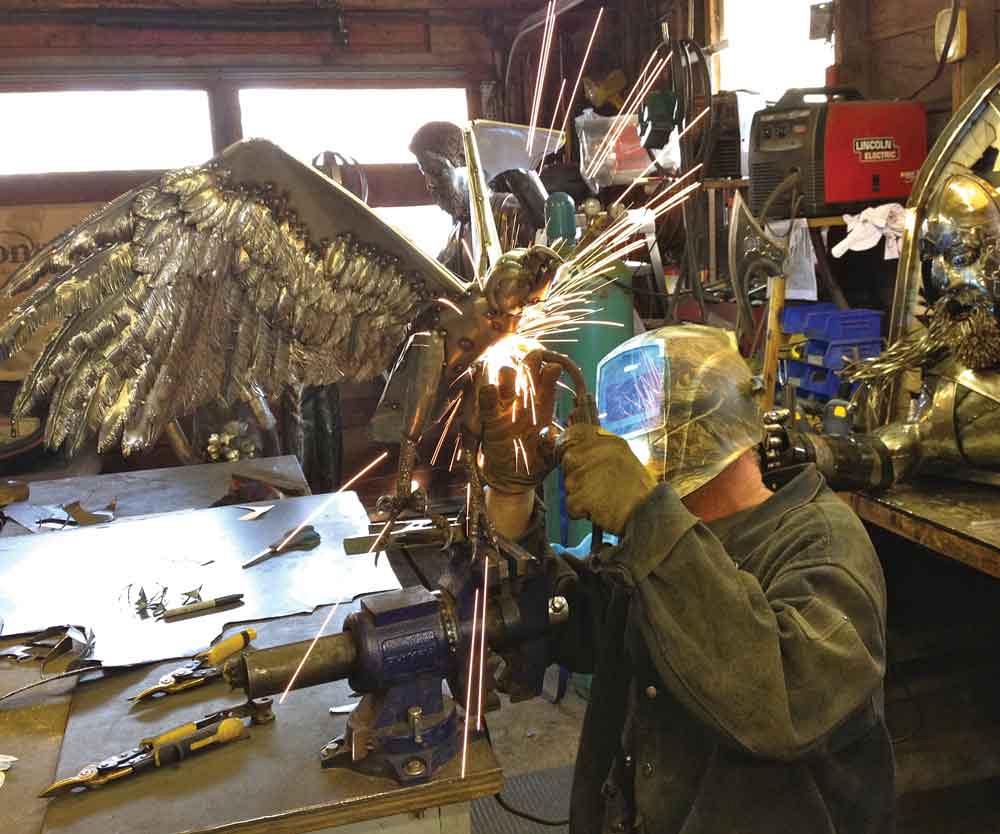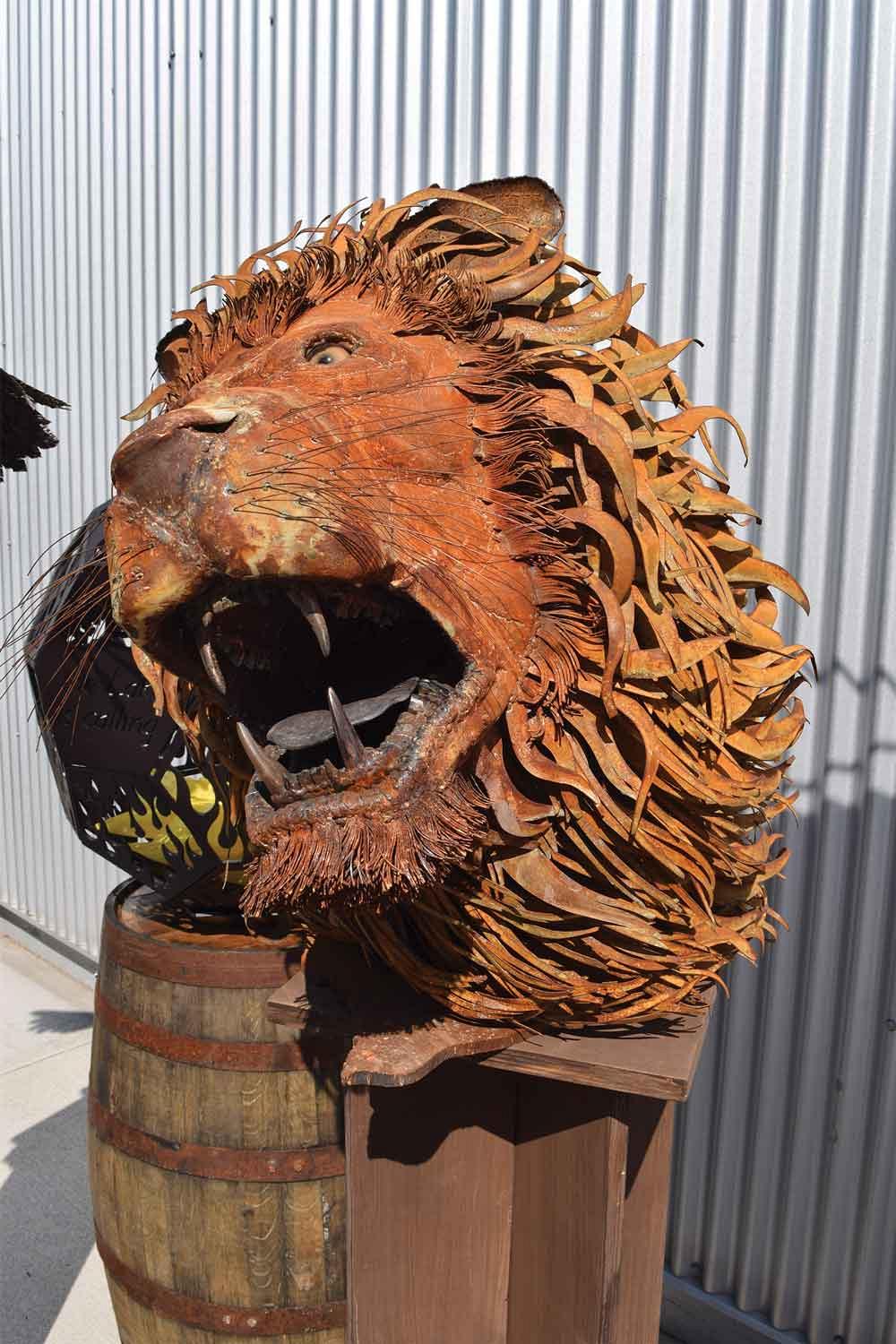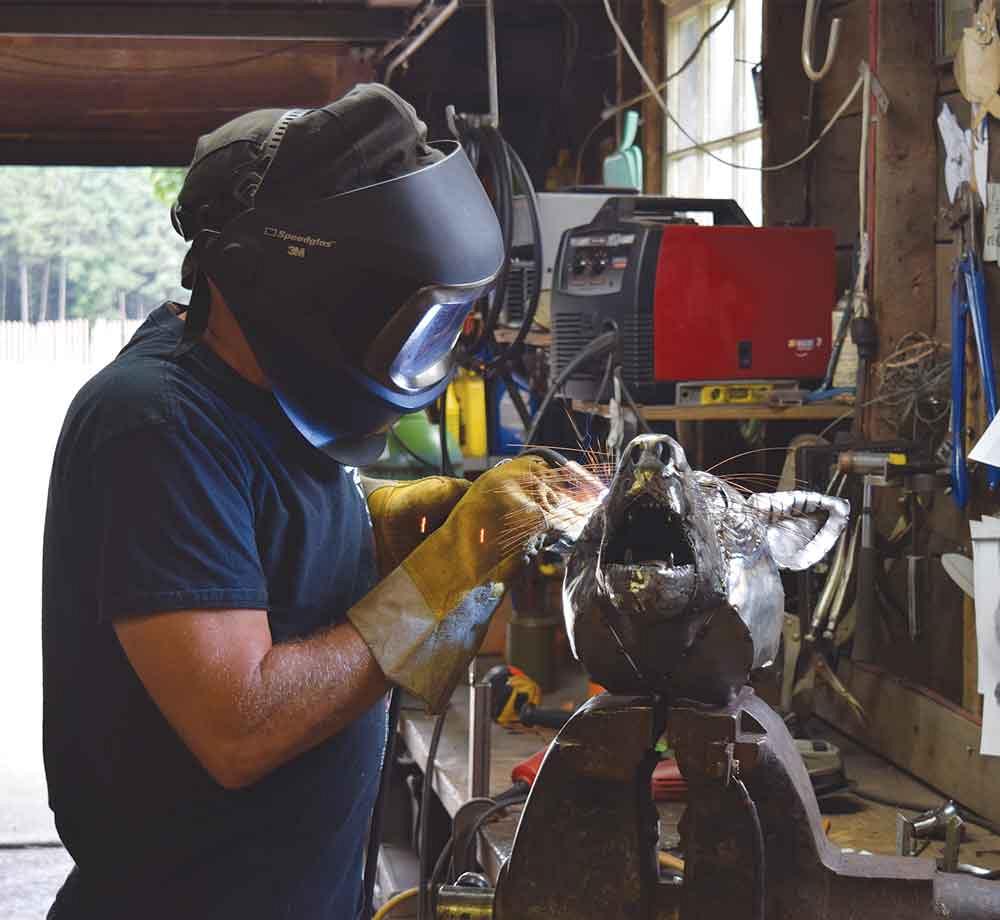Editor
- FMA
- The Fabricator
- FABTECH
- Canadian Metalworking
Metal made wild: A welder captures nature in sheet metal
- By Rob Colman
- September 27, 2016
- Article
- Welding

Baker was busy sculpting the nose and snout of a timber wolf during Canadian Fabricating & Welding's visit. Many layers of metal go into creating the most natural shape for the face of every animal. Baker usually starts with the nose on an animal and moves outward from there.
Welding is often compared to an art by those who understand how a weld is made, because a really good one demands a steady hand and a good eye. Few things in fabricating are as satisfying as a nicely laid welding bead.
Rich Baker is someone who always understood the beauty involved in a solid weld, but if you told him 20 years ago he would be making a living as a welding artist, I doubt he would have believed you. Yet for the past six years, Baker has continuously developed his skills as a sheet metal sculptor, creating vivid 3-D representations of everything from people to peregrines. He has drawn customers from around the world, thanks to his attention to detail.
From Steel to Wheels and Back
Baker started his welding career as a young man working for United Steelworkers. When his job was moved south of the border and welding opportunities in his community were scarce, Baker (with encouragement from his brother) taught himself to play guitar.
“I spent six months doing nothing else but learning that guitar and applying for jobs,” Baker recalled.
Baker’s determination with the guitar paid off. He spent the next 14 years on the road playing in his own band. The band played the Ontario circuit of clubs and bars, and even toured in the U.S., playing covers and some of Baker’s own songs. When he met his wife and started a family, he stopped touring but kept writing music. Over time he penned a number of hit country songs with musician John Landry.
But music is a fickle business, so to support his family, Baker eventually went back into the welding trade. He landed a job at the GE Power plant in Guelph, where he eventually ran the weld shop.
“I was there for about four years,” Baker recalled. “It was a great job, but after so many years on the road I found it really difficult working inside all day. I just couldn’t adjust.”
Baker’s wife encouraged him to make a change to a job that would allow him to be outdoors more often. The couple lives in farm country just south of Stratford, Ont., so setting up a business doing weld repairs on farm implements seemed a natural fit, and that was Baker’s plan.
But while he was prepping his shop to serve the agricultural community, Baker got a wholesale contract to make figurines out of old-fashioned nails that he would weld together. Over the course of six months, he made musicians, family scenes, and many other pieces using this one basic material.
Up to that point Baker had never worked with sheet metal. All the welding work he’d done was on structural steel and heavy machinery. His first attempts at sheet metal figures were a couple of carousel horses, each crafted out of two small pieces of metal.
“I created a design in cardboard, then cut the metal and welded it together,” he recalled. “I think the problem with that at the time was that I was thinking in 2-D, maybe because it was carousel horses I was modeling them after. If I were to make the same horses today, I’d use way more pieces to sculpt the shape.”
3-D Breakthrough
The breakthrough in sheet metal came for him when a friend of a friend asked Baker if he could build him a model train – a three-truck Shay locomotive, to be precise. Baker had no idea what a three-truck Shay was, but he’d never been one to say no to a challenge. This was his first true success as a sheet metal artist. Looking at pictures, you can see the attention to detail he gave to the train and its engineer. He even used a roof shingle to re-create the look and texture of coal in one of the trucks.
From the career I’ve just described, it’s easy to see that Baker is never daunted by a challenge. If he wants to understand something, he’ll work at it until he masters it. His approach to the work of sculpting, for instance, changed quite quickly. Instead of cutting out cardboard sections and trying to piece together the figurine like he did with those early horses, he now allows the work to evolve in his shop.
“I’ve learned very quickly that I can look at the anatomy of an animal and say, ‘I can make that form,’” Baker said. “But at the beginning, I would see an image in my head and think it through too much. I would hammer away at the metal but I was overthinking it.”
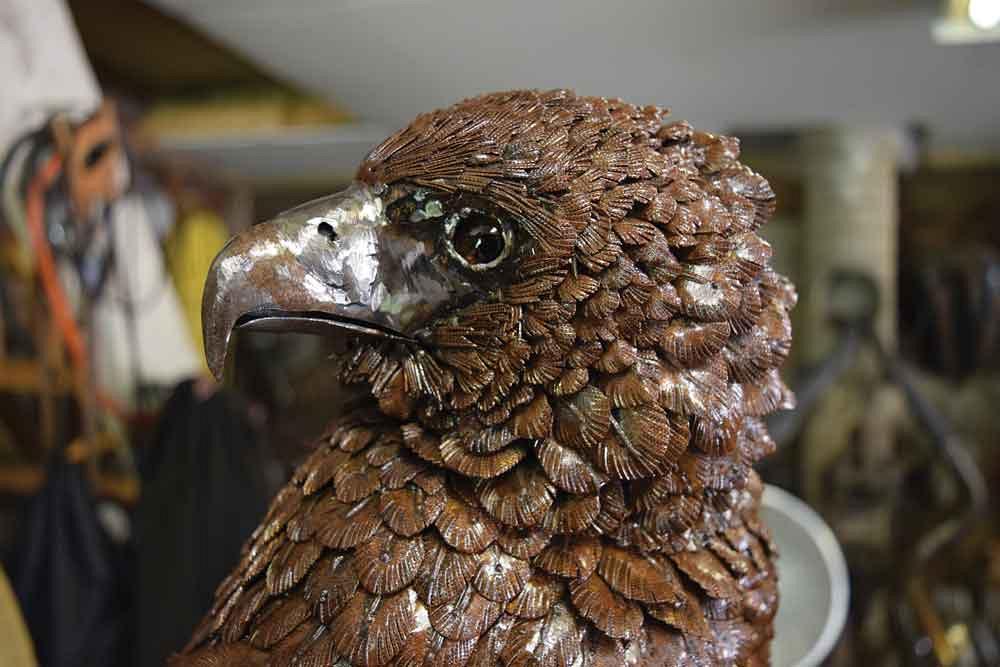
This is a Bateleur eagle, native to South Africa. Baker captures the bird as life-like as he has by cutting and etching each feather individually. The patina is created with the use of a chemical spray.
Evolving Shop Practices
Now Baker often finds a number of images of a particular animal online, prints them out, and posts them on the wall of his shop. These might stay there untouched for a number of weeks as he works on other projects, but he’ll revisit them regularly as the wheels turn in his head, considering how he might best re-create the look of that animal.
When I visited Baker’s shop, he’d just started work on a timber wolf. “With most animals, I start with the snout or the nose and work outwards from there,” he said.
Baker uses 4- by 8-ft. sheets of mild steel, in around 22 gauge and higher.
“I want to be able to manipulate the steel with ball peen hammers,” he explained. “The less heat I have to use to form a piece the better, so that I don’t get discolouration in the metal from that process.”
Most of the welds Baker makes are stitch welds using his Lincoln Electric 180 MIG machine. Again, this is to avoid too much discolouration and heat warping on the steel during the welding process. As he finishes sections, he’ll grind the surface sometimes to capture the texture of fur on an animal’s body. He was in the process of doing this with the timber wolf’s snout during my visit.
Every project Baker works on is trial and error. “I take photos at every stage of development on a sculpture, and it’s amazing how often I look back on a project and think, ‘No, I wouldn’t build it like that now.’ My process is always evolving,” Baker said.
The detail on his work is remarkable, particularly on his bird sculptures, for which he cuts and etches each individual feather.
“I want to make these sculptures so that the closer you get, the more you see,” he said.
In the case of a peregrine falcon, he even mixed in a few stainless steel feathers on the bird’s chest to imitate the colour variation one can see in such a bird’s plumage.

For this peregrine falcon, Baker was able to suggest the variation in the plumage on the bird's breast by using stainless steel for some of the feathers.
The treatment of the metal to get different colour and sheen effects has also figured into the development of his art over the past six years. For instance, in some cases he will spritz a work with water to encourage a natural rust to develop. In other cases, he uses a chemical spray that creates a different patina. For a lion he finished recently, he was able to get an interesting yellow-orange finish on the lion’s mane using a chemical spray. Baker clear-coats much of his work himself to set and protect it, but for larger projects or works that he knows will likely be displayed outdoors, he sends them out to nearby Ontario Coatings of Brownsville, Ont., to be powder-coated.
Encouraging the Trades
Although Baker does do commissions, every project underway in his shop during my visit was created from his own ideas he just knew he had to explore. Thus far, his inspiration hasn’t steered him wrong. “I’m fortunate in that I’m able to make a living with my art,” he said. “I think the key to success is perseverance. It’s all about perseverance. And I think every piece of art I create has an owner. It’s a matter of getting the two to meet.”
Baker is a big believer in the trades and has started giving back by serving as an ambassador of sorts for the CWA Foundation. He has been to their offices to give a talk to young students about the work that he does and the experiences he’s had with the trades.
“I think all kids should learn a trade in school,” he said. “We need tradespeople, and schools need to start telling kids that it’s not demeaning to be in the trades, it’s something to be proud of. And they make good money.”
Baker’s art can be viewed in person at the Algonquin Art Centre Gallery and on his website.
Editor Robert Colman can be reached at rcolman@canadianfabweld.com.
Rich Baker, 519-475-0598, www.richcraftironworks.ca
Better Vision
Being an artist working behind a welding mask can be challenging, as Rich Baker found out when he first started sculpting.
“When I first started on my sculptures, I bought my own equipment, which meant doing my best not to spend too much,” Baker recalled. “So I bought a less advanced helmet than what I’d been using at GE Power, which was a 3M Speedglas™ helmet.”
The problem with a welding helmet, of course, is that you’re usually looking at the world through a green filter. “My whole world was green for years,” Baker joked.
But just over a year ago, 3M agreed to sponsor Baker and equipped him with a 9100 FX welding helmet and a demo version of the company’s XXi lens.
“The lens brings a whole colour palette to the screen, including blues, reds, and golds,” said Baker. “For me, everything I do is fine detail, so having those colours makes the work a lot more real for me, and I can see better for that. I also think it leads to less eye fatigue as well.”
About the Author

Rob Colman
1154 Warden Avenue
Toronto, M1R 0A1 Canada
905-235-0471
Robert Colman has worked as a writer and editor for more than 25 years, covering the needs of a variety of trades. He has been dedicated to the metalworking industry for the past 13 years, serving as editor for Metalworking Production & Purchasing (MP&P) and, since January 2016, the editor of Canadian Fabricating & Welding. He graduated with a B.A. degree from McGill University and a Master’s degree from UBC.
subscribe now


Keep up to date with the latest news, events, and technology for all things metal from our pair of monthly magazines written specifically for Canadian manufacturers!
Start Your Free Subscription- Trending Articles
Class is in session for college connections
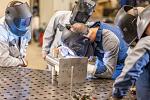
BlueForge Alliance partners with Nuts, Bolts & Thingamajigs to develop Submarine Manufacturing Camps

Engine-driven welding machines include integrated air compressors

Orbital tube welding webinar to be held April 23

Portable system becomes hot tech in heat treatment

- Industry Events
ZEISS Quality Innovation Days 2024
- April 15 - 19, 2024
Tube 2024
- April 15 - 19, 2024
- Düsseldorf, Germany
CTMA Economic Uncertainty: Helping You Navigate Windsor Seminar
- April 30, 2024
- Windsor, ON Canada
MME Winnipeg
- April 30, 2024
- Winnipeg, ON Canada
CTMA Economic Uncertainty: Helping You Navigate Kitchener Seminar
- May 2, 2024
- Kitchener, ON Canada













